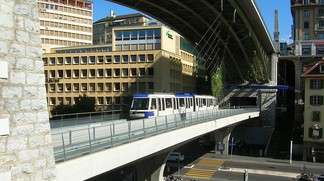City dwellers juggle with their means of transportation

A study carried out by EPFL and UNIGE and conducted in Lausanne, Geneva, Bern and Yverdon-les-Bains reports the way active urban groups have greatly diversified their modes of travel over the past two decades.
The city of Berne constitutes a model in terms of public transport and sustainable mobility. It is even an ideal for Lausanne and Geneva. The good news is that both cities are in the right path according to a study performed by the Urban Sociology Laboratory at EPFL and the University Mobility Observatory at UNIGE. The study compared data from 1994 and 2011 showing that Lausanne and Geneva's active urban groups are no longer reliant on a single mode of transport as they now combine their transportation modes according to their purposes. As a result, car usage has decreased in favor of public transportation, two wheels or even two feet.
In order to better understand what determines the choice of transportation mode, the researchers focused on three major cities: Geneva, Lausanne and Bern, as well as a smaller town, Yverdon-les-Bains. They based their study on a survey of 2,500 motorized active groups and evaluated the major developments that took place over the last fifteen years.
The study was led by Vincent Kaufmann (LASUR) and coordinated by EPFL's Transportation Center. It was financed by the cantons of Vaud and Geneva, the city of Lausanne, the town of Yverdon and Lausanne and Geneva's Public Transport network.
Public transport and two-wheelers are the most popular
In the 1990s mobility mainly revolved around the use of cars in French-speaking Switzerland. Today, the active groups' choice depends on their context or purpose. The majority opts for a public transport subscription (PT) and a two-wheeler (motorized or not). However, the disparities among the studied cities are significant: 81% of respondents had PT subscriptions in Berne. In the case of Lausanne they were 55% and in Geneva and Yverdon-les-Bains they were 48%.
The diversity of this portfolio is explained by the choice of means of transport. "Fifteen years ago, we would mainly use our cars, a bus from time to time and the bike on Sunday. At present, people are more likely to move by train and public transport and to use their cars on Sundays," explained Sébastien Munafò, researcher at LASUR and OUM.
Car use has been relegated in favor of public transport. In 1994, a third of the people surveyed in Geneva and Lausanne were frequent PT users (more than twice a week) whereas they are almost half at present. "If the people surveyed in Geneva use PT to go to work almost as frequently as the ones in Berne, at an individual level, the chosen mode of transport is in some cases more of a constraint -more or less accepted- than an actual choice," explained Sébastien Munafò.
Researchers analyzed a number of factors to explain these behavioral changes: the traffic increase, the restrictions in parking choices, the improvement of public transport, federal incentives and all efforts carried out in favor of pedestrians and cyclists... "The population of the studied cities appears very willing to using other means of transportation than cars. This is an advantage for carrying out policies aimed at developing eco-mobility," summarized Vincent Kaufmann.
A matter of image
The changes observed are related to means of transport that have themselves too, changed dramatically. Cars are now perceived as polluting and sometimes more harmful than beneficial. The reputation they've lost has been public transport's gain. For example, PT's positive image has doubled from 30% to 61% in Lausanne. "The improvement of public transport's image is unprecedented," said Christian Liaudat, in charge of mobility projects at the State of Vaud. He sees the construction of the M2 metro line combined with a better RER offer as the reason behind this increase in popularity. In Geneva, the image of public transport has also improved from 39% to 52% positive perceptions.
The study's recommendations confirm the strategy proposed by the Canton of Geneva, says Damien Cataldi, engineer on analysis and mobility projects at the Directorate-General for Mobility in Geneva. "The "Mobility 2030" strategy pursued by the canton on Geneva aims at facilitating the practice of multimodality and in fact responds to the changes in people's observed behavior."
For its part, Lausanne is required to "avoid a two-tier development of public transport as all of its areas are not equally equipped, and to "reduce the parking availability at work." In the case of Yverdon-les-Bains, it is a fast growing town and its inhabitants are still quite attached to using their cars. Its strategy should "bet on soft mobility for travelling within the city."
More information: The study and a synthesis of "Typology and evolution of modal choices logics behind motorized urban groups" are available, in French, at: transport.epfl.ch/mode_choice
Provided by Ecole Polytechnique Federale de Lausanne





















